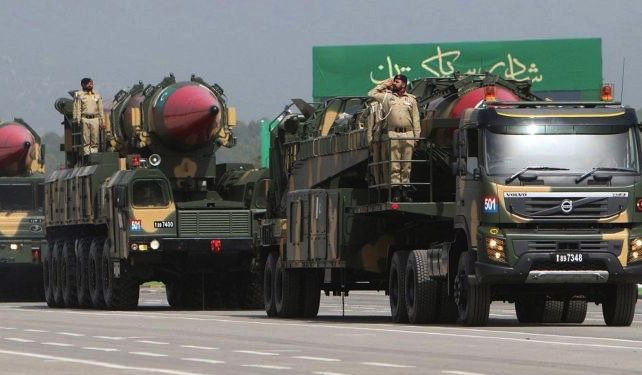By Samra Hamid
The recent imposition of US sanctions on Pakistan’s ballistic missile program has ushered in a wave of debate and concern, particularly regarding their far-reaching implications particularly on security balance, affecting regional stability in South Asia.

These sanctions, aimed at curtailing Pakistan’s missile development activities, target key institutions such as the National Development Complex and various private entities. Pakistan’s Ministry of Foreign Affairs (MoFA) has denounced the sanctions as “unfortunate and biased,” arguing that they exacerbate military asymmetries and undermine regional peace and stability. This move marks a significant escalation in US policy and rhetoric towards Pakistan’s strategic capabilities, raising critical questions about the future of regional security dynamics.
The MoFA’s statement highlights the perceived double standards in US foreign policy, pointing out that similar sanctions have not been applied to other countries with advanced missile programs. This sentiment was seconded by former Pakistani envoy, Dr. Maleeha Lodhi, describing the sanctions as discriminatory and ineffective in curbing Pakistan’s strategic capabilities.
The US has often been criticized for its preferential treatment of India, particularly in the context of strategic partnerships and defense cooperation. For instance, the US has provided India with advanced military technology and support, while imposing stringent sanctions on Pakistan. The US’s reluctance to criticize India’s domestic policies, such as the revocation of Article 370 in Jammu and Kashmir, emboldens India to pursue further controversial actions, potentially disregarding international concerns.
Deputy National Security Adviser Jon Finer emphasized that Pakistan’s actions regarding the development of its missile program raise “real questions” about its intentions, suggesting that Islamabad’s missile capabilities could potentially target regions beyond South Asia, including the United States itself. However, on the contrary, India’s Agni-V being an intercontinental ballistic missile (ICBM) with a range of over 7,000 kilometers, capable of reaching targets across Asia and into Europe, remains unnoticed.
The US imposed sanctions on Pakistan after its nuclear tests, mirroring the response to India, but with significantly less severity towards India, showcasing US biased foreign policy in South Asia. With this, it is quite clear that the US views India as a counterweight vis-à-vis China that is perceived to be a potential threat to the US predominance in the region. Therefore, any security threat created by India remains unnoticed in the eyes of the US. Intentionally, whatever and however India acts are ignored for geopolitical reasons.
The imposition of these sanctions is likely to intensify the security dilemma in South Asia—a concept in international relations where actions taken by one state to enhance its security cause insecurity in other states, leading to an arms race and heightened tensions. These sanctions could also have significant geopolitical ramifications, pushing Pakistan closer to China, its long-standing ally.
As Pakistan seeks to counterbalance the growing Indo-US partnership, it may deepen its military and economic ties with China, potentially altering the strategic balance in South Asia. According to the MoFA, “such actions only serve to destabilize the regional balance, compelling Pakistan to strengthen its deterrence capabilities further.”
In the context of South Asia, the US sanctions on Pakistan could prompt Islamabad to further bolster its missile and nuclear capabilities as a deterrent against the perceived threats from both the US and India. This, in turn, could trigger a corresponding response from India, escalating the arms race in the region and against Pakistan. For India, the sanctions are a clear indication of US support in its strategic rivalry with Pakistan, potentially emboldening New Delhi’s stance. Ultimately, leading to more assertive policies by India, including accelerated development of its own missile and defense capabilities against Pakistan.
The motivations behind the US sanctions on Pakistan’s missile program are debated, with some viewing them as an effort to curb nuclear proliferation, while others see them as a tactic to limit China’s growing influence in the region. Critics argue that the sanctions are part of a broader strategy to contain China’s influence in the region, with Pakistan being viewed as a key player in China’s Belt and Road Initiative (BRI).
By targeting Pakistan’s missile capabilities, the US aims to curtail China’s strategic reach and limit its influence in South Asia and beyond. However, this approach carries risks. Such an outcome would counteract US objectives and potentially create a more formidable regional bloc. Additionally, it could strain US relations with other regional actors, including allies who may view the sanctions as destabilizing.
In conclusion, the US sanctions on Pakistan’s ballistic missile program aim to counter China while presenting the situation as addressing proliferation concerns. It risks exacerbating the security dilemma in South Asia. By intensifying regional rivalries and prompting an arms race, these sanctions could undermine efforts to achieve long-term peace and stability in the region. It is crucial for all stakeholders to engage in constructive dialogue and pursue balanced approaches to security that consider the complex dynamics of South Asia. The need for diplomacy and multilateral cooperation has never been greater. Only through inclusive dialogue and mutual respect can the global community build a future that is balanced, equitable, and sustainable, mitigating the risks of conflict and fostering a stable and secure South Asia.
Author: Samra Hamid – Research Fellow at Balochistan Think Tank Network, Quetta.
(The opinions expressed in this article are solely those of the author and do not necessarily reflect the views of World Geostrategic Insights).
Image Credit: AFP







